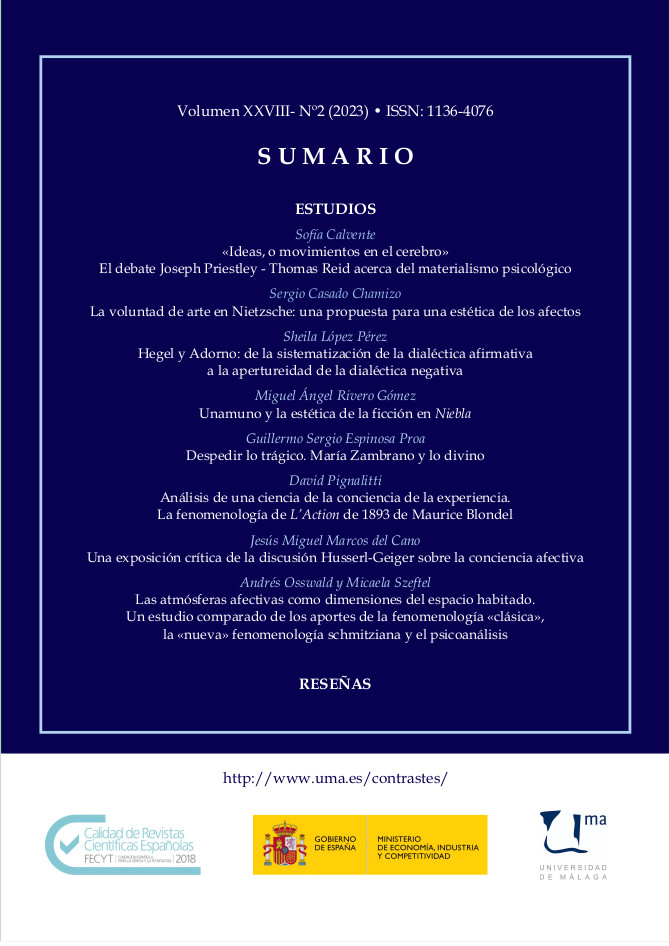The Will to Art in Nietzsche: A Proposal for an Aesthetics of Affects
DOI:
https://doi.org/10.24310/Contrastescontrastes.v28i2.14414Keywords:
Nietzsche, will to power, aesthetics of the passions, psychology of the affections, will to artAbstract
This text suggests a reading of the aesthetic proposal of the young Nietzsche from the point of view of the aesthetics of the passions in his theory of the will to power. It analyses his intellectual development from The Birth of Tragedy to his psychophysiological conversion of art in his mature stage, while at the same time studying the repercussions of this evolution on his approach from the psychology of the affections. In this way, although it is true that Nietzsche's intellectual course changes now, he abandons the metaphysics of the artist, he continues to delve into an aesthetic proposal from the affective tendencies of psychology and the body.
Downloads
Metrics
Publication Facts
Reviewer profiles N/A
Author statements
Indexed in
-
—
- Academic society
- N/A
- Publisher
- Universidad de Málaga
References
ASTOR, D. 2018: Nietzsche. La zozobra del presente. Barcelona: Acantilado.
BARRIOS, M. (2005), «Nietzsche y el retorno romántico a la naturaleza», Estudios Nietzsche, 5, pp. 33-66.
BODEI, R. 1995: Una geometría de las pasiones. Miedo, esperanza y felicidad: filosofía y uso político. México: Fondo de Cultura Económica.
BROWN, S. y STENNER, P. (2001), «Being Affected: Spinoza and the Psychology of Emotion», International Journal of Group Tensions, 30-1, pp. 81-105.
DAMASIO, A. 2013: En busca de Spinoza: Neurobiología de la emoción y los sentimientos. Barcelona: Destino.
DELEUZE, G. 2016: Nietzsche y la filosofía. Barcelona: Anagrama.
DE PABLOS ESCALANTE, R. E. (2016), «La voluntad como deseo consciente: Kuno Fischer entre Spinoza y Nietzsche», Anales del Seminario de Historia de la Filosofía, 33-1, pp. 137-161.
FOUCAULT, M. (1988): Nietzsche, la genealogía, la historia. Valencia: Pre-Textos.
GONZÁLEZ, A. M. (2015), «Emoción, sentimiento y pasión en Kant», Trans/Form/Ação, 38-3, pp. 75-98.
INFANTE DEL ROSAL, F. (2020), «Problematicidad de la emoción en la estética moderna. Negaciones y alternativas», Bajo Palabra, 24, pp. 361-384.
KANT, I. 2007: Crítica del juicio. Madrid: Tecnos.
KRIEGEL, U. (2014), «Towards a New Feeling Theory of Emotion», European Journal of Philosophy, 22-3, pp. 420-442.
MARTÍN SÁNCHEZ, M.ª A. F. (1989), «Arte y liberación en Schopenhauer», Taula, 11, 109-125.
NIETZSCHE, F. 2008-2010: Fragmentos póstumos. Madrid: Tecnos. 4 vols.
NIETZSCHE, F. 2011: Obras completas. Madrid: Tecnos. 4 vols.
NIETZSCHE, F. 2012: Correspondencia. Madrid: Trotta. 6 vols.
ROLDÁN LÓPEZ, C. (2018), «Nietzsche con Spinoza: estética de la inmanencia y potencia artística del pensamiento», Claridades, 10-1, pp. 93-105.
ROSA SILVESTRE, L. (2015), «Nietzsche y Wagner: renacimiento de la tragedia griega», Anuari de Filologia. Antiqva et Mediaevalia, 5, pp. 1-13.
SAFRANSKI, R. 2019: Nietzsche: biografía de su pensamiento. Barcelona: Tusquets.
SALMERÓN INFANTE, M. (2012), «Wagner y la filosofía, Wagner como filosofía», Bajo palabra. Revista de filosofía, II Época, 7, pp. 129-139.
SÁNCHEZ MECA, D. 2005: Nietzsche. La experiencia dionisíaca del mundo. Madrid: Tecnos.
SANTIAGO GUERVÓS, L. E. (2000), «El arte como función de la vida en F. Nietzsche», Contrastes. Revista Interdisciplinar de Filosofía, 5, pp. 243-262.
SANTIAGO GUERVÓS, L. E. 2004: Arte y poder: aproximación a la estética de Nietzsche. Madrid: Trotta.
SCHOPENHAUER, A. 2016: El mundo como voluntad y representación. Madrid: Trotta.
SEUNG, Th. K. 2006: Goethe, Nietzsche, and Wagner: their Spinozan epics of love and power. Oxford: Lexington.
SILK, M. S. y STERN, J. P. 1984: Nietzsche on Tragedy. Cambridge: Cambridge University Press.
SOLOMON, R. 1983: The Passions: the myth and nature of human emotions. Notre Dame (Indiana): University of Notre Dame Press.
SPIERLING, V. (1995), «Nietzsche y Schopenhauer: una comparación», Enrahonar, 25, pp. 21-39.
SPINOZA, B. 2016: Ética demostrada según el orden geométrico. Madrid: Alianza.
STORER, J. B., et al. (2017), «Teoría de la Autodeterminación: una revisión teórica», Perspectivas en Psicología: Revista de Psicología y Ciencias Afines, 14-2, pp. 105-115.
VIGOTSKY, L., 2006: Psicología del arte. Barcelona: Paidós.
WAGNER, R. 1952: La poesía y la música en el drama del futuro. Madrid: Espasa-Calpe.
WAGNER, R. 2005: El Anillo del Nibelungo. Madrid: Turner.
WHITING, D., 2009: «The feeling-theory of emotions and the object-directed emotions». European Journal of Philosophy, 19-2, pp. 281-303.
Downloads
Published
How to Cite
Issue
Section
License
This journal provides immediate free access to its content under the principle of making research freely available to the public. All content published in Contrastes. Revista Internacional de Filosofía, are subject to the Creative Commons Attribution-NonCommercial-ShareAlike 4.0 license whose full text can be found at <http://creativecommons.org/licenses/by-nc-sa/4.0>
It is the responsibility of the authors to obtain the necessary permissions of the images that are subject to copyright.
Authors whose contributions are accepted for publication in this journal will retain the non-exclusive right to use their contributions for academic, research and educational purposes, including self-archiving or repository in open access repositories of any kind.
The electronic edition of this magazine is edited by the Editorial Service of the University of Malaga (Uma Editorial), being necessary to cite the origin in any partial or total reproduction.










5.png)
